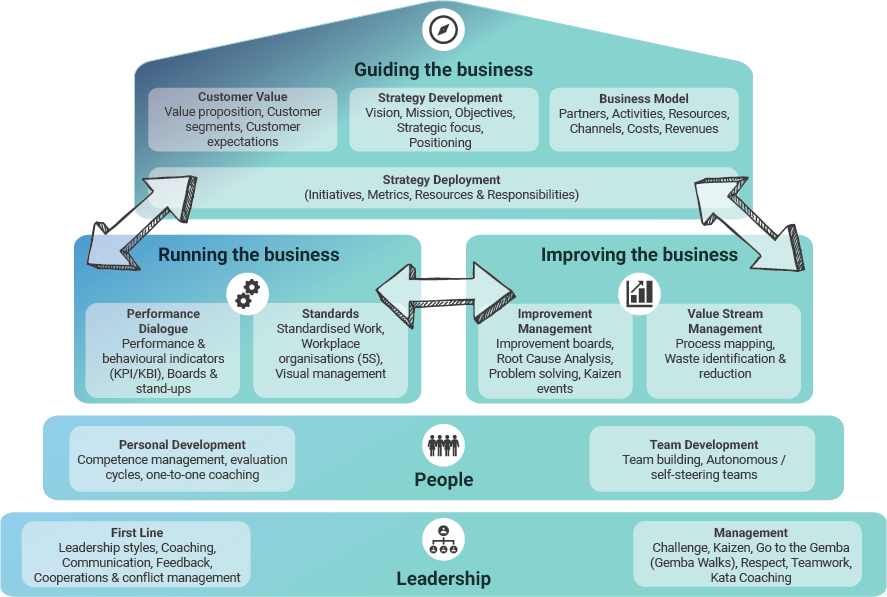Processes as a foundation for Enterprise Excellence
During the Global Process Improvement & Operational Excellence Summit in March 2025, we had the privilege of giving a keynote. The keynote concerned processes as a foundation for sustainable operational excellence. In this keynote, we introduced our broad Enterprise Excellence Model.
From Operational Excellence to Enterprise Excellence
Operational Excellence is often launched with energy and enthusiasm. But sustaining that momentum is where many organisations stumble. This is often due to several factors:
-
No constancy of purpose. Without a steady focus on long-term goals, it's easy for initiatives to lose direction when internal priorities shift or external challenges arise.
-
Excellence is seen too narrowly. Focusing only on improving operations isn’t enough. True success comes from Enterprise Excellence, which touches every part of the organisation, not just one department or function.
-
Efforts are too limited. Trying to improve in just one team or at one level of the company rarely leads to lasting change. Excellence needs to be organisation-wide.
-
Change does not come from within. While leadership support is needed, real improvements happen when employees, who are the true experts, are empowered to act.
-
The right systems are missing. Culture, which is the sum of our behaviours, is what drives excellence. And systems drive behaviour, so without well-designed, effective systems, even the best intentions fall flat.
To conquer these obstacles, Möbius developed the Enterprise Excellence Model. It is a practical framework built on five interconnected pillars:

-
Guiding the business: This involves strategy development and deployment, ensuring everyone in the organisation understands the direction and purpose of the organisation. Without this alignment, even the best bottom-up initiatives risk going lost.
-
Running the business: Structured performance dialogues and standards support us in stabilising our business. The dialogues focus on monitoring and adjusting frequently to make sure that we reach our defined targets. Standards, on the other hand, are needed since how else can we improve, if there is no base to start from?
-
Improving the business: Rushing into improvement without stability leads to failure. So once successful at running the business, we can start to improve, setting the bar consistently higher. Either via improvement management (structured problem solving, improvement ideas, …) or via process management and (end-to-end) improvement.
-
People: Employees are the company's experts, so enough opportunities should be given to them to develop themselves personally as well as within their team/organisation.
-
Leadership: Leaders, in the broad sense, have a pivotal role in the organisation. They are the driving force behind the change from top management to first-line managers. They also need to be supported such that they too can demonstrate the desired behaviours.
We’ve seen firsthand how these principles come to life:
- At a pharmaceutical wholesaler, implementing an Obeya room transformed how teams collaborated. Daily visual management and short, structured meetings led to a 25% boost in productivity. The key? Keeping it analogue—manual updates kept people engaged and accountable.
-
In process management workshops, the manager failed to complete the assigned homework for the second workshop. At the next workshop, almost no one had finished their homework... Leadership by example matters—and so does the ability to give and receive feedback.
How does process management fit in?
The examples below display why process management is a critical tool for achieving enterprise excellence.
-
At a life insurance provider, process mapping and dashboards allowed for real-time monitoring of customer drop-off points, leading to improved customer and employee satisfaction.
-
Multi-departmental process mapping workshops at a gypsum manufacturer enhanced understanding and collaboration. Implementing process confirmation, a lean tool for verifying adherence to standards, and reviewing processes every six months with employees ensured accuracy and continuous improvement.
-
A Dutch telecom operator integrated process management deeply into its industrial model, aligning operations and IT systems across multiple countries, ensuring control, consistency, and speed.
In short, reasons for implementing process management include aligning with new systems, controlling costs and risks, meeting service levels, bridging organisational gaps, enabling faster adaptation, facilitating harmonisation during mergers, and ensuring compliance. Failure to manage processes effectively carries risks in these areas.
Applying the PDCA cycle to process management involves systematically mapping processes, ensuring they function as desired, using them to identify improvements, and then implementing and sustaining those improvements through consistent follow-up, like process confirmation.
Conclusion: Embed excellence by process management
To conclude, the Enterprise Excellence model provides a framework for improvement by addressing strategy, operations, and people. Processes are vital for driving progress across all these areas and should be actively managed and used for continuous improvement, not just for compliance.
At Möbius, we don’t just help organisations become excellent. We help them stay that way. Want to know more about our view on Enterprise Excellence? Download our mini-guide.

.png?width=1200&height=1200&name=Mini-guide%20banner%20LinkedIn%20(3).png)




-1.jpeg?width=410&height=220&name=possessed-photography-dRMQiAubdws-unsplash%20(1)-1.jpeg)

